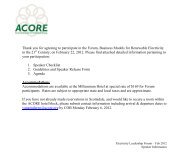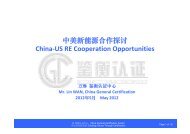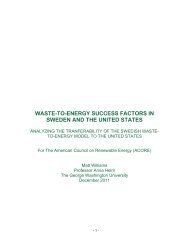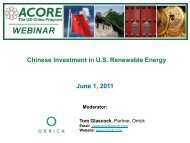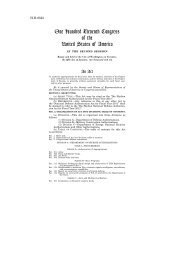Read More - American Council On Renewable Energy
Read More - American Council On Renewable Energy
Read More - American Council On Renewable Energy
You also want an ePaper? Increase the reach of your titles
YUMPU automatically turns print PDFs into web optimized ePapers that Google loves.
Federal policy should allow for a competitiveelectricity market while still promoting increaseduse of renewable energy.Competitive electricity markets drive renewable energy,demand response and innovation. In regions with organizedcompetitive electricity markets and transparentmarket prices, customer choice and renewable standardsare providing a favorable environment for renewables.Further, additional safeguards such as price caps, creditworthinessrequirements and real-time monitoring byindependent market monitors protect customers.Green Power MarketsSpanning the gap between consumers’expressed interest in receiving environmentallysound energy and their willingness to make thecorrect decision at the point of purchase is achallenge.While there is high consumer interest insustainability, participation rates are low.How do we increase understanding andparticipation? Programs offers have to be simpleand provide an emotional connection soconsumers feel they are part of a communityworking together to make a difference.Solutions must also be meaningful and effectivefor generations. Lastly, offers must be viewedas trustworthy, transparent, and reliable.Voluntary purchases play a major role in drivingthe US renewable energy market.The future of the industry relies on gettingcustomers into the market with distributedrenewable energy resources, smart gridenabled technology, energy efficiency andcontrollable demand.– Joseph Kerecman, Senior Vice President Viridity <strong>Energy</strong>In 2007 renewable energy sales were 15.7 million MWh,up 60% from 2006. Voluntary purchasers of renewablepower pay a premium price for electricity, but in someinstances customers are now paying less than nonsubscribersdue to rising natural gas prices. Successfulprograms offer clear choices, find support from localleaders and utilize media sources to convey programbenefits. Programs that have not proven successful tendto have confusing enrollment offers and spend too muchmoney on marketing and administrative costs.ConclusionsRecognizing the urgency of the 21 st centuryenergy challenges, the utility industry is workingto transform the way we generate, supply,transmit, store and use energy. A strong andenduring energy policy that reduces USindependence on foreign oil, invests in newtechnologies, and results in the diversifying ofenergy sources is necessary if the utility sectoris to succeed in the transition.Session ReferencesA1 - Utilities: Strategic Issues in <strong>Renewable</strong> <strong>Energy</strong>John Geesman, Former Commissioner, California <strong>Energy</strong> Commission (Chair)John Bohn, Commissioner, California Public Utilities CommissionWilliam Massey, Counsel to COMPETE Coalition (and former FERC Commissioner), Partner, Covington & Burling [slides]Daniel Kammen, Class of 1935 Distinguished Professor of <strong>Energy</strong>, <strong>Energy</strong> and Resources Group, Founding Director,<strong>Renewable</strong> and Appropriate <strong>Energy</strong> Laboratory, University of California [slides]<strong>American</strong> <strong>Council</strong> <strong>On</strong> <strong>Renewable</strong> <strong>Energy</strong>Executive Summary Report 61






